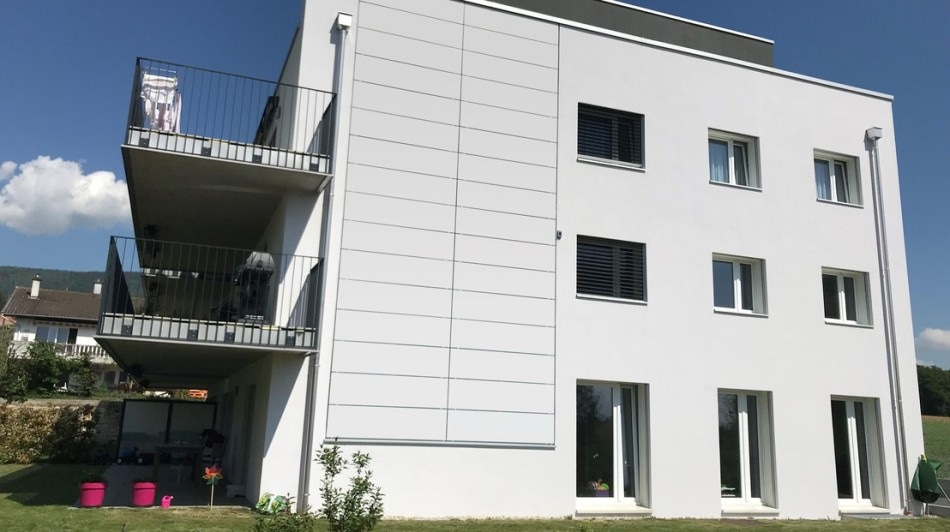Mar 12 2019
EPFL has turned as the coordinator of Be-Smart, an EU research project that works toward increasing the use of building-integrated photovoltaics (BIPV) and reducing their costs by 75% from present to 2030. This project was established following EU regulations that demand nearly zero-energy new buildings by 2020.
 Credit: EPFL
Credit: EPFL
BIPVs have the potential to be used directly in renovation and building projects and can act as a construction material in their own ability. Solar panels integrated into roofs and facades can convert buildings into electricity producers and decrease the release of carbon dioxide. To advance and stimulate this technology, Be-Smart project collaborators have developed versatile solar panels with the potential to generate energy and function similar to other building materials with soundproofing, insulating, or aesthetic qualities. The project collaborators will also design a methodology for construction companies and architects and discover approaches to achieve marked reduction in the costs of BIPV.
A Boon for Europe’s Manufacturing Industry
A total of 15 innovative companies, research institutes, and architecture and construction firms have been working together for this challenging project, led by EPFL and the CSEM in Neuchâtel.
The use of BIPV in facades and in the construction sector more broadly is expanding rapidly, thanks in part to the pioneering technology developed by EPFL and CSEM. But we need to make this technology more accessible so that it can be used more extensively and not just in flagship building projects.
Laure-Emmanuelle Perret-Aebi, Project Coordinator, Photovoltaics and Thin Film Electronics Laboratory (PV-Lab), EPFL.
The increased adoption of this technology would significantly increase the demand for photovoltaic tiles, facades, and other construction materials, which would prove to be a boon to the manufacturing industry in Europe.
The technology is different from that used in solar panels, which are designed for mass production and now manufactured primarily in China. But BIPV technology stands to boost European industry.
Laure-Emmanuelle Perret-Aebi, Project Coordinator, Photovoltaics and Thin Film Electronics Laboratory (PV-Lab), EPFL.
This technology also uses solar energy—another of its chief features that given the latest advance in this field.
Solar energy produces 10 to 20 times less CO2 than conventional thermal power plants. What’s more, large solar farms are the cheapest way of producing electricity, even in countries that don't get a lot of sunlight, like Germany.
Christophe Ballif, Professor, School of Engineering, EPFL.
Ballif is also the head of EPFL PV-Lab and the director of the CSEM PV-center.
A Shift in Mind-Set
Even earlier, renovation or construction of a building using BIPV has been feasible. In Switzerland, over 10,000 roofs have already been constructed using this method, where photovoltaic panels come in many colors and shapes. However, there is still much hesitancy and the adoption of this technology is gradual. Although the use of BIPV increases the construction costs, the additional amount will be paid off within a span of one to three decades, without the need for using potential grants or selling back the electricity generated. Moreover, it does not account for the reductions in the release of CO2 that can be achieved.
A Standard for All New Buildings
In this project, the photovoltaic technology based on crystalline silicon, present in many solar panels, has been used. As the panels are required to have a sure lifespan of 30–50 years if they are to be incorporated into buildings, reliability is important—and one of the aims of the project. Presently, for a solar panel, the energy payback period—that is, the time required for the panel to produce the same amount of energy used to build it—is between 1 and 3 years. The project collaborators say that the extensive use of this technology in roofs and facades has the potential to produce approximately the amount of energy consumed at present in Switzerland.
There is really no reason not to integrate photovoltaic panels into new buildings—it should be the norm.
Christophe Ballif, Professor, School of Engineering, EPFL.
Funding
Launched in October 2018, Be-Smart will prolong for 4 years. With a total budget of 8,155,173 euros, it was financially supported by Horizon 2020, the EU’s research and innovation program, under Grant Agreement No. 818009.